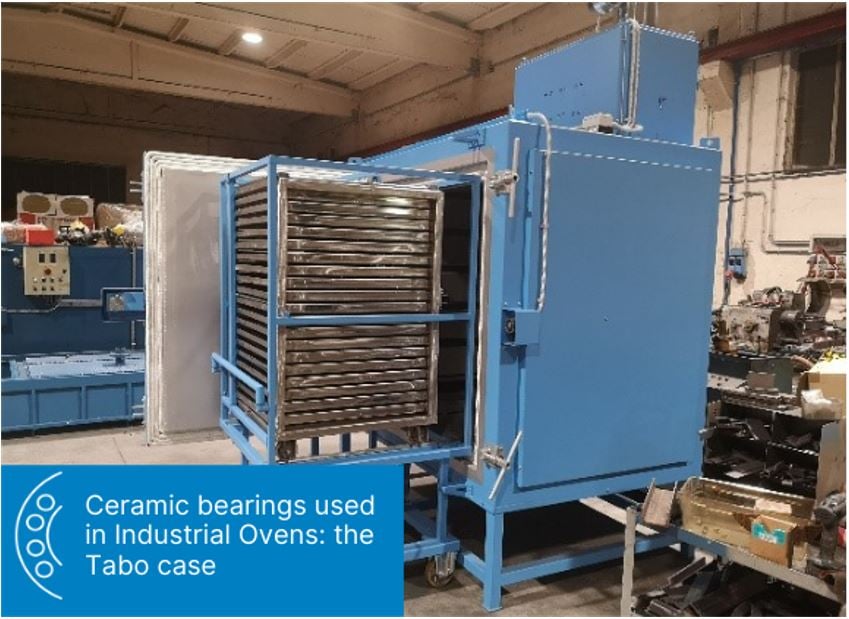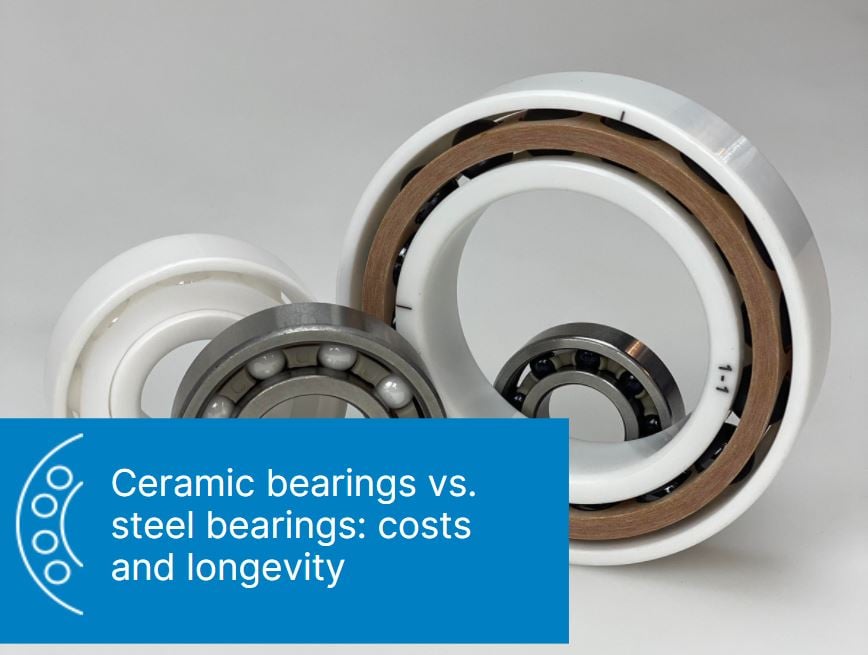
An aspect that is often not considered in the selection of bearings to be used inside a machine or equipment is the rolling torque, i.e. the torque required to keep one bearing ring rotating at a constant speed relative to the other.
It is the internal friction of the bearing that generates the rolling torque. The greater the friction, the greater the rolling torque.
As a measure of the internal friction of a bearing, the rolling torque can be important because it causes a power dissipation which, on the one hand, lowers the efficiency of the mechanical transmission and on the other hand manifests itself with the generation of heat and a potential increase temperature of the bearing itself and of the mechanical parts in contact.
Let's have a look at the sources of friction in a bearing:
- Movement (rotating / sliding) of the rolling elements in relation to the bearing rings
- Interaction of the rolling elements with the cage
- Interaction of the cage with the bearing rings
- Interaction of rolling elements, cage, rings and any seals with the lubricant
- Interaction of seals with bearing rings
- Bearing clearance or preload
- Number of rolling elements carrying the load and, therefore, type of load
- Material from which rings and rolling elements are made
- Hardness of the material from which rings and rolling elements are made
- Roughness of rings and rolling elements
- Bearing accuracy degree
- Bearing temperature
Let's analyze them one by one.
1.Movement (rotating / sliding) of the rolling elements in relation to the bearing rings
Inside a bearing, the contact between the rolling elements and the tracks is normally schematized as a point in the case in which the rolling elements are spheres or a line in the case in which the rolling elements are cylinders. In reality, contact does not occur through a point or a line but through a surface which generally takes the shape of an ellipse. In this contact surface, only a small portion is characterized by pure rotary motion with rolling friction. In the remaining part, the motion of the rolling body is of the sliding type with respect to the track and therefore characterized by a sliding friction. It is clear, therefore, that the larger the contact surface, the greater the friction between the rolling element and the track. Therefore anything that can lead to a reduction of the contact surface will lead to a reduction of the rolling torque.
2.Interaction of the rolling elements with the cage
The rolling bodies of a bearing, except in special cases, are guided in their motion by using a cage that can be made of different materials depending on the applications. The cage does not have its own motion, but is set in motion by the rolling elements. This means that mainly sliding will occur between the rolling elements and the cage. The greater these sliding or the greater the friction between the rolling elements and the cage, the greater the rolling torque. Proper selection of cage material and shape can lead to a reduction in rolling torque.
3. Interaction of the cage with the bearing rings
During the rotational movement of the bearing it can happen that the cage crawls on the bearing rings. This leads to an increase in the rolling torque.
4.Interaction of rolling elements, cage, rings and any seals with the lubricant
Normally a lubricant is inserted inside a bearing whose purpose is not only to minimize the possibility of direct contact between rolling elements and raceways but also to improve heat dissipation. Furthermore, the lubricant, distributing itself inside the bearing, comes into contact with the cage, rings and any seals. If there is relative movement between the lubricant and the bearing elements, friction will be created which will increase the rolling torque. Similarly, relative movement can be created between the various layers of lubricant with the generation of friction and an increase in the rolling torque. The quantity of lubricant, therefore, must be determined carefully because, if present in too high a quantity, it can lead to a considerable increase in internal friction with an increase in the rolling torque.
5.Interaction of seals with bearing rings
In some applications it is necessary to use sealed bearings (the so-called RS versions). The seals of the watertight bearings are made of rubbery material and, to exert their effect, they are made to slide on one of the two rings. This, of course, causes friction with increased rolling torque.
6. Bearing clearance or preload
The contact surface between the rolling element and the raceway is important for the rolling torque, both in terms of extension (the greater the surface, the greater the friction) and in terms of the number of contact surfaces. In a bearing with clearance, the greater the clearance value, the fewer the number of rolling elements actually in contact with the raceways. In a zero clearance bearing, all rolling elements are in contact with the raceways. In a bearing with preload, all the rolling elements are not only in contact with the raceways but are also "squashed" on the raceways thus resulting in a higher contact surface than both the zero and positive play bearing. This means that rolling torque increases when changing from play to preload. To reduce the torque it is good to choose bearings with the highest possible clearance, compatibly with the application.
7.Number of rolling elements carrying the load and, therefore, type of load
Since the rolling torque depends on the width of the contact surface between the rolling elements and raceways as well as on the number of rolling elements actually in contact with the raceways, the type and value of the load to which the bearing is subjected considerably influence the torque value. rolling. Typically, the increase in load involves an increase in the rolling torque. It is for this reason that there is no absolute value of the rolling torque of a bearing, but must always be associated with a well-defined load condition (normally, the value of the rolling torque is evaluated with the bearing unloaded).
8.Material from which rings and rolling elements are made
The material from which the rings and rolling elements are produced directly affects the size of the contact surface. More elastic materials will have a wider surface with an increase, therefore, other things being equal, of the rolling torque.
9. Hardness of the material from which rings and rolling elements are made
The hardness of the material also influences the rolling torque as the higher the hardness, the smaller the contact surface between the rolling elements and the raceways and the lower the rolling torque.
10.Roughness of rings and rolling elements
The roughness of the contact surfaces directly affects the friction coefficient and thus the rolling torque. The greater the roughness, the greater the rolling torque.
11. Degree of bearing accuracy
The degree of precision of a bearing can affect the rolling torque because it involves the ovalization of the races. In theory, the raceways of a bearing should be perfectly circular. In reality, due to the machining tolerances, a certain ovality will always be present. The ovalization means that the contact surface between the tracks and rolling elements is not constant but may vary with the rotation of the rings. This could lead to increased rolling torque. The degree of accuracy can become important for rolling torque with bearings with low clearance or preload.
12. Bearing temperature
Bearing temperature may have an effect on rolling torque because it can positively and negatively affect some causes of friction. For example, an increase in temperature decreases the viscosity of the lubricant with beneficial effects on the rolling torque. At the same time, however, an increase in temperature could cause thermal expansions of different values between the bearing rings, affecting the contact surface between rolling bodies and raceways; with an increase in the surface, an increase in the rolling torque could occur, thus neutralizing the beneficial effect of reducing the viscosity of the lubricant.
From the above, it can be deduced that the request for the supply of a bearing with a rolling torque that does not exceed a defined value, must be accompanied by the conditions in which the torque must be verified: load conditions (value and type of load) , number of revolutions, bearing position (axis of rotation horizontal, vertical or at a predetermined angle), temperature. The lubrication conditions should also be specified, i.e. quantity and type of lubricant, however it must be considered that the tolerance on the quantity of lubricant inserted in a bearing can be wide, causing equally large variations in the value of the rolling torque. For this it is preferable to define the rolling torque in the absence of lubricant.
But, at this point, what can be done in case there is a need for a bearing with low rolling torque? Let's see what solutions can be adopted.
With normal steel bearings the possible solutions, compatibly with the conditions of use or with the cost limits, are the following:
- Maximize the bearing clearance
- Reduce the number of rolling elements
- Use small amounts of lubricant
- Use a low viscosity or low friction lubricant (for example use oil instead of grease)
- Use bearings with super finish of the raceways to reduce roughness
- Use bearings with a high degree of accuracy
- In case of sealed bearings, use low friction seals; this can be achieved either by using suitable materials or by special versions of the bearings with grinding of the sliding seat of the gaskets. It is also possible to use seals which, although "watertight", are not actually in contact with the bearing ring but inserted in a labyrinth
- Use low friction materials for the cages (eg PA6 or PTFE instead of steel cages)
A different solution, an alternative to steel bearings, which allows the value of the rolling torque to be reduced to a minimum, is represented by fully ceramic bearings. In these bearings, rings and rolling elements are made of ceramic material while cages and any seals are made of plastic.
Let's see the peculiarities of ceramic bearings in relation to the 12 sources of friction shown above:
-
Movement (rotating / sliding) of the rolling elements in relation to the bearing rings
The contact surface between rolling elements and raceways in a ceramic bearing is smaller, with the same dimensions and load conditions, than the corresponding steel bearing. This means that the area subject to sliding is smaller and, therefore, the friction that occurs is also less. In addition to this, the sliding and rolling friction coefficient of a ceramic / ceramic pair is lower than the coefficient of friction of the steel / steel pair. All this leads to a reduction in the rolling torque.
-
Interaction of the rolling elements with the cage
In fully ceramic bearings, the cage is made of plastic material (normally PEEK or PTFE). The coefficient of friction between rolling elements made of ceramic material and the cage is lower than that which occurs in steel bearings. For this reason, the contribution to the rolling torque of the friction between rolling bodies and cage in fully ceramic bearings is lower than that which occurs in steel bearings.
-
Interaction of the cage with the bearing rings
Also in this case, the friction coefficient between cage and rings is lower than that which occurs in steel bearings and, consequently, the contribution to the rolling torque is lower.
-
Interaction of rolling elements, cage, rings and any seals with the lubricant
One of the peculiar characteristics of fully ceramic bearings is the need for significantly less lubrication than steel bearings, even reaching the possibility, on certain occasions, of totally eliminating it. This means that this component of the rolling torque can be drastically reduced.
-
Interaction of seals with bearing rings
Precisely because the fully ceramic bearings are characterized by a very low rolling torque, any seals are always of the non-sliding type, thus eliminating this component.
-
Bearing clearance or preload
Even in the case of fully ceramic bearings, the increase in play leads to a reduction in the rolling torque. Therefore, determining the correct degree of play / preload can have a significant influence on the final value of the rolling torque.
-
Number of rolling elements carrying the load and, therefore, type of load
For this point, the same considerations as above apply to steel bearings.
-
Material from which rings and rolling elements are made
The material with which the rings and the rolling bodies of the fully ceramic bearings are produced has a lower elasticity than steel and it is for this reason that the contact surface, all other conditions being equal, is lower, having a beneficial effect on the value of the rolling torque.
-
Hardness of the material from which rings and rolling elements are made
The ceramic materials with which the fully ceramic bearings are made have very high hardness, higher than the hardness obtainable from hardened bearing steels. This also means that the contact area is reduced with a reduction in the rolling torque.
-
Roughness of rings and rolling elements
Thanks to the characteristics of ceramic materials, the roughness obtained in bearings is lower than that of steel bearings, further reducing the coefficient of friction and, consequently, the rolling torque.
-
Degree of bearing accuracy
The same considerations made for steel bearings apply. As the precision of the bearing increases, all other conditions being equal, the rolling torque is reduced.
-
Bearing temperature
Even for fully ceramic bearings, the bearing temperature could have an influence on the rolling torque value. However, since the coefficient of thermal expansion of ceramic materials is lower than that of steels, the influence of thermal expansion on the rolling torque could be less.
From the above, it can be concluded that in situations where it is required to reduce the rolling torque of the bearings as much as possible, the choice of fully ceramic bearings can be a winner.
In any case, the replacement of a steel bearing with a totally ceramic bearing leads to a reduction in the rolling torque with an increase in the efficiency of the mechanical transmission and a reduction in the dissipated power.
Find the right bearing for your applications with the technical support of our best experts.








